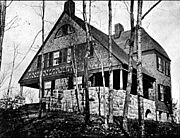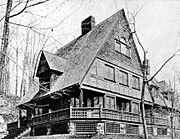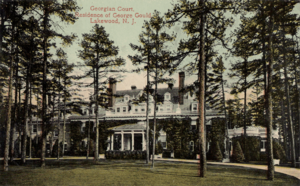Bruce Price facts for kids
Quick facts for kids
Bruce Price
|
|
|---|---|
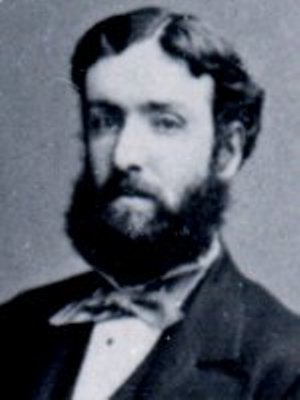 |
|
| Born | December 12, 1845 Cumberland, Maryland, United States
|
| Died | May 29, 1903 (aged 57) Paris, France
|
| Nationality | American |
| Alma mater | Princeton University |
| Occupation | Architect |
| Spouse(s) | Josephine Lee |
| Children | 2, including Emily Post |
Bruce Price (born December 12, 1845 – died May 29, 1903) was a talented American architect. He was famous for his new ideas in the Shingle Style of building. This style often used wooden shingles on the outside, making buildings look cozy and natural.
His unique designs, especially the simple and strong shapes of his cottages in Tuxedo Park, New York, inspired many later architects. Even famous designers like Frank Lloyd Wright learned from Price's work. Bruce Price also designed grand buildings in other styles, like fancy mansions and tall skyscrapers in New York City. In Canada, he created beautiful train stations and large hotels for the Canadian Pacific Railway, such as the famous Château Frontenac in Quebec City.
Contents
Life and Career: Bruce Price's Journey
Frank Lloyd Wright may have modeled his Oak Park house and studio after these two cottages.
Bruce Price was born in Cumberland, Maryland. He briefly studied at Princeton University. After learning from experienced architects for four years, he started his own work in Baltimore. He also traveled to Europe to study architecture. Later, he opened his own office in Pennsylvania.
In 1877, Price moved to New York City. There, he designed many homes. His biggest project was helping to plan and design Tuxedo Park. This was a large, exclusive community built in the mid-1880s. The buildings Price designed there were very striking. They had clear, strong shapes and were built to fit into the natural surroundings. These designs became very influential.
Eight of Price's houses, including five from Tuxedo Park, were featured in a famous book about American homes. One of his most well-known designs was the Pierre Lorillard V cottage, known as "Cottage G." Even though it no longer exists, photos of it are still important in architecture. Price's daughter, Emily Post, who became famous for her books on etiquette, wrote about Tuxedo Park. She said her father wanted the buildings to blend in with the woods. He used natural colors like browns, grays, and dull reds for the shingled cottages.
Price also designed many important buildings in Manhattan. These included the American Surety Building and the Bank of the Metropolis. He worked with a famous sculptor, Daniel Chester French, on the Richard Morris Hunt Memorial in Central Park. He also designed buildings for Yale University. One of his grandest homes was "Georgian Court" in New Jersey. This large estate was built for a wealthy businessman named George Jay Gould I.
Bruce Price was also an inventor. He created special parlor cars for trains, which were like fancy lounges on wheels. This work led the Canadian Pacific Railway to hire him. He designed the iconic Château Frontenac in Quebec City, which looks like a grand castle. He also designed the first Banff Springs Hotel in Alberta, Canada, and many other hotels and train stations.
Price was a respected member of the American Institute of Architects. He formed a partnership with another architect, Jules Henri de Sibour, in 1900. The firm continued to use Price's name even after he passed away in 1903.
In 1871, Bruce Price married Josephine Lee. They had two children. Their daughter, Emily Post, became a very famous writer on good manners and social rules. Their son, William, sadly died when he was a baby. Bruce Price is buried with his wife and son in Pennsylvania.
Selected Works: Bruce Price's Buildings
Bruce Price designed many different types of buildings across the United States and Canada. Here are some of his notable projects:
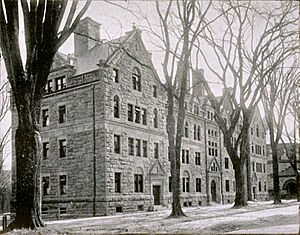


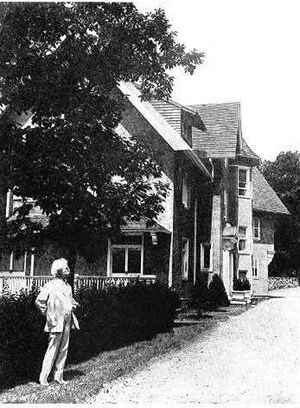
- Coryell Apartment Building, Manhattan, New York (1878).
- "Cleftstone" (Charles T. How cottage), Bar Harbor, Maine (1881). Today, it is the Cleftstone Manor Hotel.
- "Seaverge" (George F. Baker residence), Monmouth Beach, New Jersey (c. 1884, now gone).
- Cordelia Sterling residence, Stratford, Connecticut (1886).
- Osborn Hall, Yale University, New Haven, Connecticut (1887–88, now gone).
- Welch Hall, Yale University, New Haven, Connecticut (1891).
- Main Building, Hotchkiss School, Lakeville, Connecticut (1892, now gone).
- Elizabeth Train Station, Elizabeth, New Jersey (1893–94).
- American Surety Building, Manhattan, New York (1894, changed over time).
- "The Turrets" (John J. Emery house), Bar Harbor, Maine (1895). Now part of College of the Atlantic.
- St. James Building, Manhattan, New York (1896).
- "Georgian Court" (George Jay Gould I mansion), Lakewood, New Jersey (1896). Now Georgian Court University.
- Richard Morris Hunt Memorial, Central Park, New York City (1898), with sculptor Daniel Chester French.
- Daniel B. Wesson residence, Springfield, Massachusetts (1898, destroyed by fire).
- Old Washington County Library, Hagerstown, Maryland (1900).
- Audrain Building, Newport, Rhode Island (1902).
- Bank of the Metropolis, Manhattan, New York (1902–03).
Tuxedo Park, New York
Bruce Price played a huge role in designing the entire community of Tuxedo Park.
- Tuxedo Park Post Office (1885).
- Gate-Lodge and Keep (1885–86).
- Erie Railroad Tuxedo Park Station (1885).
- "Cottage G" (Pierre Lorillard V Cottage) (1885–86, now gone).
- William Kent Cottage (1885–86, now gone).
- W. Chanler Cottage (1885–86, changed over time).
- The Tuxedo Club (1886, now gone).
- Pierre Lorillard IV Cottage (1886, changed over time).
- Henry I. Barbey Cottage (1886, now gone).
- Travis Van Buren Cottage (1886, changed a lot).
- Bruce Price Cottage, Pepperidge Road (1897).
- Voss Cottage, Pepperidge Road (c. 1897). Samuel Clemens (Mark Twain) rented this in 1907.
- Emily Post cottage (c. 1897). Bruce Price built this for his daughter.
- Tuxedo Park Library (1901).
Canada
- Windsor Station, Montreal, Quebec (1887–89).
- Banff Springs Hotel, Banff National Park, Alberta (1888, now gone).
- James Ross House, Montreal, Quebec (1892). Now part of McGill University.
- Château Frontenac, Quebec City, Quebec (1893).
- Place Viger, Montreal, Quebec (1897). This was both a train station and a hotel.
Gallery
-
Windsor Station, Montreal, Quebec (built 1887–89).
-
Banff Springs Hotel, Banff National Park, Alberta (completed 1888; demolished 1925).
-
Main Building, Hotchkiss School, Lakeville, Connecticut (completed 1892; demolished 1970).
-
Place Viger, Montreal, Quebec (completed 1897).
-
Bruce Price Cottage, Tuxedo Park, New York (completed 1897).
See also
- Canada's railway hotels
- Canadian Pacific hotels
- Canadian Pacific Railway


